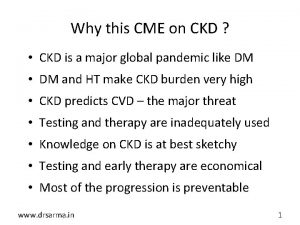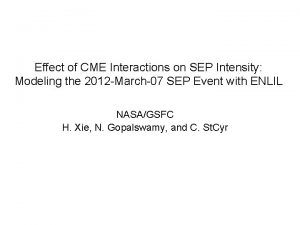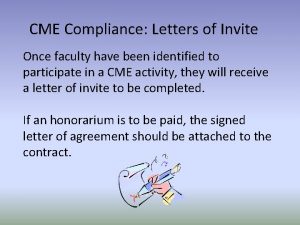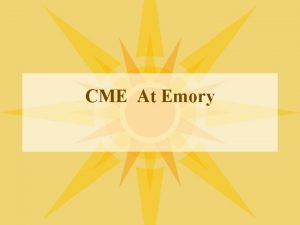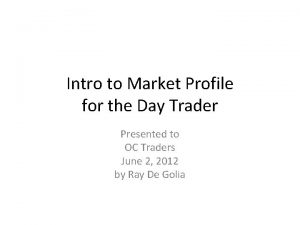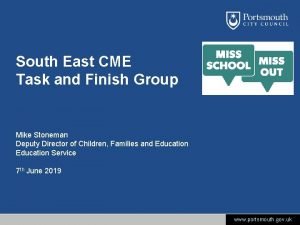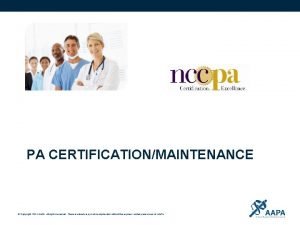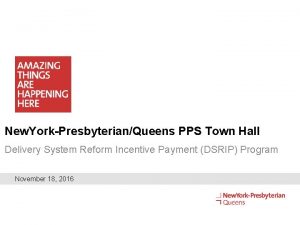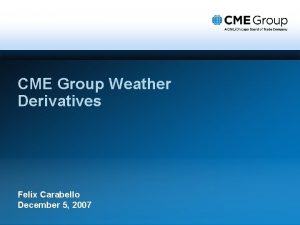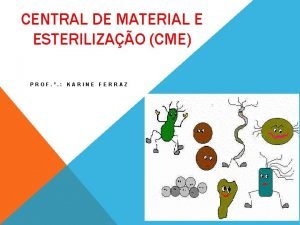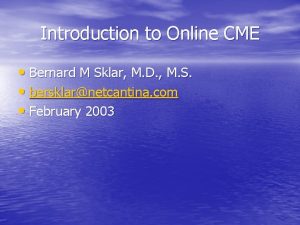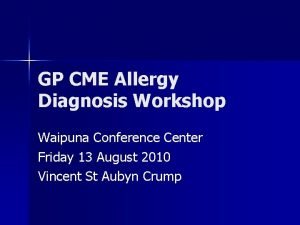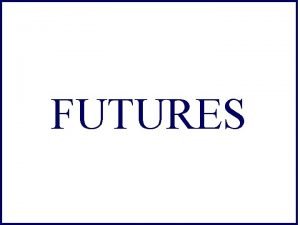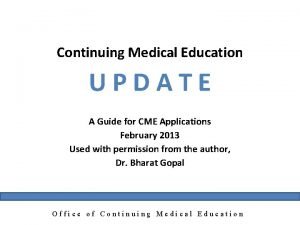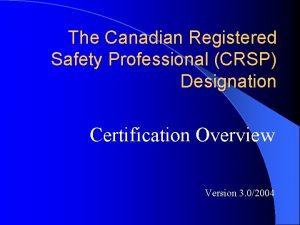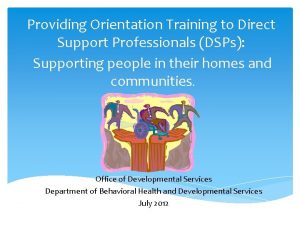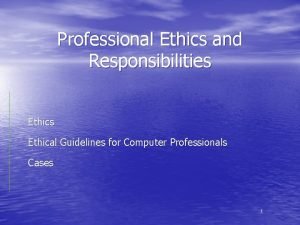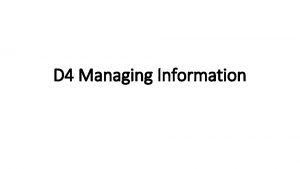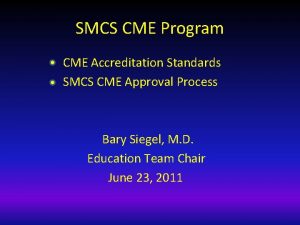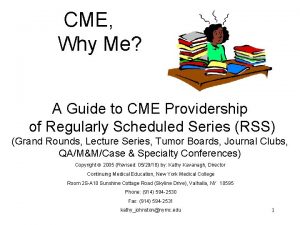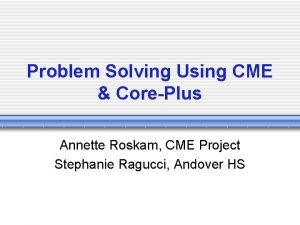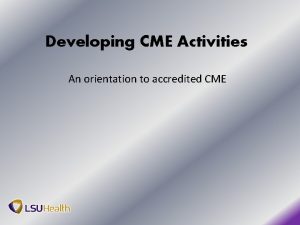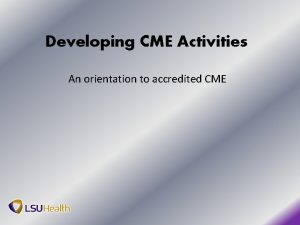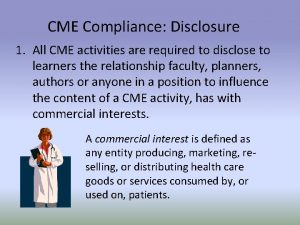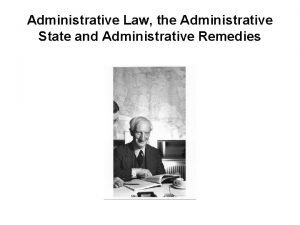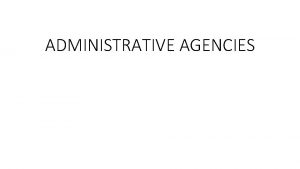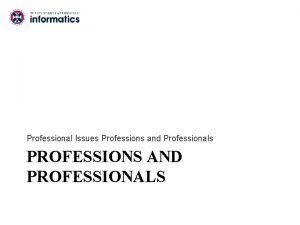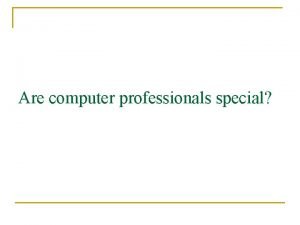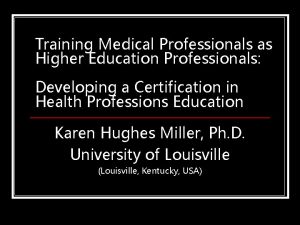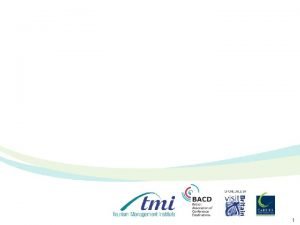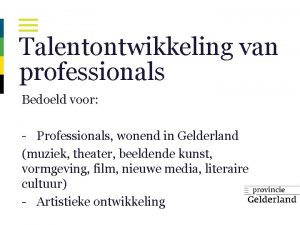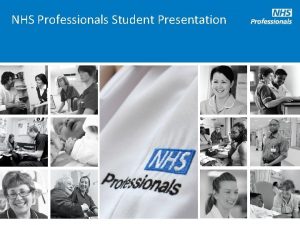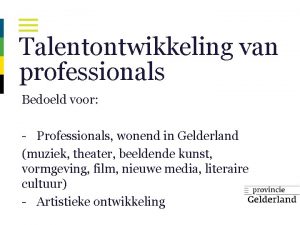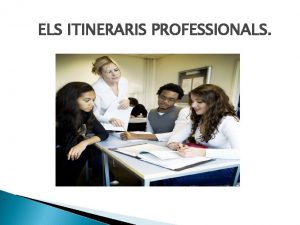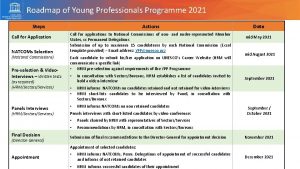CME Why Me A Guide for Administrative Professionals

































































































- Slides: 97

CME, Why Me? A Guide for Administrative Professionals Copyright 2002 by: Kathy J. Kavanagh, Director Revised: 05/29/18 Continuing Medical Education, New York Medical College Room 2 S-A 10 40 Sunshine Cottage Road (Skyline Drive) Phone: (914) 594 -2530 Fax: (914) 594 -2531 Kathy_johnston@nymc. edu 1

What the Heck is CME, and why should you care? 2

The High Brow Answer: CME (Continuing Medical Education) consists of educational activities which serve to maintain, develop, or increase the knowledge, skills, and professional performance and relationships that a physician uses to provide services for patients, the public, or the profession. 3

What this means in English: CME consists of educational activities that teach practicing doctors new information and skills so they can take better care of their patients. 4

But they are doctors. They already have had years of training, why do they need more education? 5

Because, as in any field, things change. New problems are discovered, as are new solutions. 6

CME is one way that doctors can remain up-to-date, both in their specialty and in medicine in general. 7

So doctors have a moral obligation to continue their education, why do you have to get involved? 8

Because, over the course of time, CME, like many other areas, has become regulated. E M C 9

Many States now require that a physician obtain CME credits for re-licensure. 10

Most Specialty Boards require CME for continued certification. 11

Virtually every hospital requires that a physician obtain CME credits for hospital appointments and re-appointments (credentialing). 12

So they need CME, but who decides how much credit, if any, a CME activity is worth? And, how does a physician prove he/she participated in CME activities? 13

In 1968, the American Medical Association (AMA), came to the rescue with the Physicians Recognition Award (PRA). SS AMA 14

The PRA has become the standard for recognizing physicians’ participation in CME. 15

But, Can just anyone “designate” an activity for PRA credit? PRA Credit 16

No. The AMA wanted to ensure that activities designated as CME for the PRA were quality activities that met their criteria for continuing medical education. 17

The ACCME (Accreditation Council for Continuing Medical Education) was formed to monitor providers of PRA designated CME. 18

The ACCME’s job is to help ensure CME activities are of scientific merit and appropriate for the people who participate. 19

New York Medical College is accredited by the ACCME to provide CME for physicians. 20

The NYMC Office of CME works to help identify and plan CME activities. CME 21

In order to maintain our accreditation and ability to designate PRA credit, we must follow the rules of both the ACCME and the AMA. ACCME AMA 22

And yes, there are rules - a lot of them! ACCME AMA 23

These rules do have a purpose (other than to torment you and the participating physicians). 24

CME Rules “The Highlights” “Rules Starrin of CM E” g: ACC ME & AMA 25

The process used to plan, execute, and evaluate a CME activity must all be linked together. 26

CME must: • Be based on an Identified “gap in practice” What this means is that the group at which the activity is directed must have demonstrated in practice that they need to acquire new information or skills. In even plainer English, “What are the doctors not doing that they could do that would improve their patients’ health? ” 27

What exactly is a “Gap? ” What Docs are currently doing in their practice Practice Gap What Docs should be doing to improve their patients’ health 28

So, How do you “Identify the Gap”? – You must first identify the accepted standard of care and/or screening for a specific condition – You must then assess your physicians’ current practice (what your physicians {the target audience} are/are not currently doing for the same specific condition) – The difference between what your physicians should be doing and what they are currently doing is the “Practice Gap” 29

Where can gaps be found? – There are many ways in which gaps can be identified. Some examples are: • QA/QI Reviews • Specialty Society Guidelines • Public Health Data, Chart Audits, Hospital Discharge Data • Physician Self Assessment • Government Mandates • Current Medical Literature • Program Evaluation Data 30

Connecting gaps to your learners… If you used data on a national or state level to identify a practice gap, you must show you connected that gap to your own learners. 31

All CME Activities need to be developed in the context of desirable physician attributes (ACGME/ABMS Competencies) • Patient Care • Medical Knowledge • Practice-based Learning • Intrapersonal Skills • Professionalism • Systems-based Practice 32

Ok, now that you have a “gap” then what? Why does this gap exist? • Is it due to your target audience’s lack of: – Knowledge (factual information, being aware), – Competence (Strategies for/ or knowing how to do something), or – Performance (carrying out a strategy or task)? How can you best address this gap? • What do you hope to accomplish with this activity? • This becomes the Activity Goal 33

Once you have defined “who needs to learn what”, what do you do next? X Who X What How When Where 34

You now need to figure out the best way to achieve your activity goal. • Should it be a lecture? A workshop? A computer based lesson? A hands-on skill training session? Or a combination of methods? • If we are going to certify people in open-heart surgery, then it might be a good idea to have hands-on training before we let them loose in the operating room! 35

You must also ask yourself what this activity is designed to change. • Do you hope to improve: – Physicians’ Competence (new abilities/strategies) – Physicians’ Performance (modify practice) – Patient Outcomes 36

Going Hand-in-Hand with this is, exactly what are you hoping they will learn, and how will you know if they learned it? Through the formulation of “learning objectives” Objectives should be: • clear • measurable • learner oriented Example: “As a result of participating in this activity, the learner should be able to identify and define the key terms used in CME. ” 37

You also need to pick the right instructors for the activity. Martha Stewart might be a good choice for teaching people how to make gifts out of soup cans, but I don’t think I would want her teaching brain surgery! 38

You also need to decide how to measure the activity’s success in reducing the “Practice Gap”. • This “evaluation” can be in many forms but must relate to the type of change you hoped to make (competence, performance, or patient outcomes) • Some examples of evaluation methods are: – Follow-up questionnaires – Review of patient data - Pre/post tests 39 - Focus groups

In order to be as successful as possible in helping learners make the desired change in practice, you should use Non. Educational strategies to support the activity’s goal 40

Non-Educational Strategies include: • • • Checklists Pocket Reminders Decision Making Charts Best Practices/Specialty Guidelines Associated Websites Course Companion Booklet Post Activity Email Reminders Patient Education Material Posters 41

Each activity MUST include at least one Non-Educational strategy. 42

You should also take into account, that no matter how well you design an activity, some participants may feel that Barriers exist that preclude them from making a change. 43

Being aware of some common barriers to change can help you design a better activity. • • Lack of evidence-based guidelines Outdated testing and treatment practices Lack of teamwork on interdisciplinary teams Lack of confidence in successfully utilizing new skills/techniques • Failure to listen adequately to patients 44

There are some educational strategies that you can utilize to overcome these barriers to change • Programs designed to improve physicians’ communication skills with patients and colleagues (role playing, team building, etc. ) • Including updated disease state and prevalence in the area(s) in which the participants practice • The use of standardized patients and patient simulators in educational activities • The incorporation of evidence-based guidelines 45 into educational activities

No matter how well you plan an activity, there will always be factors outside your control that might affect patient outcomes in relation to this activity. Activity Improved Patient Outcomes 46

Factors Outside your control include: • • • Participants lack of time to change behavior Physicians’ communication skills The healthcare team’s workloads Costs of care for patients Costs of pharmaceuticals Regulatory Requirements Health Disparities Patient autonomy for decision-making Inconsistent standards and approaches to care 47

Since the goal of CME is to fill a gap in physicians’ performance to improve patient care, we should ask the learners what changes they will try to make as a result of participating in the activity. 48

We can then follow-up with the learners to see if they made the change, and if they didn’t make a change, what prevented them. 49

This follow-up should be done 3 -6 months after the activity and can be accomplished by: • Sending a follow-up questionnaire to participants • Reviewing chart, QA, or hospital discharge data to see if patient care has improved • Holding focus groups 50

So, you have done your homework - You: • identified the gap & the target audience • selected the best activity method • picked the most suitable instructor(s) • wrote clear and measurable learning objectives to address the gap • Identified and addressed barriers to change • created an appropriate evaluation method to measure the activity’s success Now you just need to figure out. . . 51

How to get people to come to the activity! E M C New ! y t i v i Act 52

Advertising is the Answer! 53

A brochure is the most common way to advertise an activity. 54

Brochures are useful because: • They are relatively inexpensive • They can contain all the activity details (time, place, topic, etc. ) • If designed well, they can generate interest in an activity • They can be easily distributed 55

It is important to note, however, that all advertisements need to be approved by the CME Office prior to distribution. • Yup, it is those pesky “rules” again. • The CME office must make sure that the correct statements are included, and that items that are not allowed, are excluded. 56

Wow, You told lots of people about the great program and they all want to participate – Now, you just need to figure out how to pay for it all! 57

Uh oh, you just discovered that your rich uncle didn’t leave you a fortune, How ever will you pay for all this? 58

Everyone needs some help at times, and it is perfectly ok to have outside companies help support a CME activity. CME Activity 59

It is ok for even Pharmaceutical Companies and Device Manufacturers to Contribute. 60

Drug and Device companies often contribute to, and may even fully underwrite, CME Activities. It is legal and acceptable as long as the company does not control any part of the activity or provide any guidance on the content of the activity or on who should deliver the content. 61

Any entity producing, marketing, re-selling, or distributing health care goods or services consumed by, or used on, patients is considered to be a “Commercial Interest” Note: providers of clinical service directly to patients are not considered commercial interests. 62

To ensure that activities remain wellbalanced and unbiased Certain rules must be followed by the: Commercial Interests, Activity Director, Faculty, CME Office, and Participants. 63

These rules are called the “Standards for Commercial Support” (SCS, for short). SCS 64

Highlights of SCS • Activities must be free from commercial bias for or against any product • Any off-label use discussed in an activity must be clearly identified as being “off-label” • Therapeutic options discussed in an activity must be objective and balanced • Generic, not brand, names should be used whenever possible • All Funds from a Commercial Interest must come to and/or with the knowledge of the CME Office 65

SCS Highlights, Continued • No commercial promotional materials may be displayed or distributed in the same room as the educational activity – (Yes, this means that banners, pens, pads, etc. can’t be displayed or distributed in the educational room. ) • Support cannot be contingent on the provider relinquishing control over any part of the activity 66

SCS Highlights, Continued • The terms, conditions, and purposes of any commercial support must be outlined in a signed agreement between the activity director, the commercial interest, and the CME Office • No payments may be made directly by a commercial interest to activity faculty or to directly pay any activity expenses • All commercial support must be acknowledged in announcements, brochures, and hand-outs 67

SCS Highlights, Continued • Commercially supported social events at CME activities should not compete with or take precedence over the educational event(s). 68

AND, most importantly. . . • To ensure that activities are un-biased, prior to the activity, each Activity Faculty member and Planner must disclose to the provider any significant relationship(s) with all commercial interests. • If the potential for a perceived conflict of interest (COI) is identified, the provider must take steps to resolve this conflict before the activity. 69

Sample Mechanisms for resolving COI • End the Relationship • Have an impartial person review the presentation content to ensure it is wellbalanced and unbiased • Remove the person from participating in the planning and presentation of the activity 70

Stress Out Example: • Clarence Clinician, MD has been invited to give a talk about stress-reduction interventions at your annual conference • Dr. Clinician indicates that he owns 50% of the stock of “Stressbusters” the manufacturer of a pill that lowers adrenaline levels • It could be perceived that Dr. Clinician might be biased towards the Stressbusters drug over otherapeutic options 71

This doesn’t mean Dr. Clinician can’t be a part of our conference 72

Steps must just be taken to ensure that his presentation is well balanced. 73

It is ultimately up to the audience to decide if the presentation is unbiased. 74

If we resolved the potential Conflict of Interest, why do speakers and planners, still have to disclose? My Name is Clarence Clinician And I own stock In Stress. Busters. 75

Because, the audience needs to know with which companies a speaker has a relationship, to be able to determine If the presentation is influenced. 76

Who Has to “Disclose”? For CME purposes, any person who has control over a CME activity (e. g. planner, presenter, moderator, instructor) is considered part of the “activity faculty” and/or “planning committee” and must provide disclosure information. 77

How do you go about getting this information from the activity faculty? 78

Each activity faculty member and planner is asked to complete a “Financial Disclosure Form” This Form asks information regarding financial relationships with commercial interests and/or manufacturers of products discussed in their presentations. 79

The faculty member and planner must indicate either: • They have no significant relationship • They have a relationship (and then state the nature of the relationship) • They are refusing to disclose any information regarding relationships – Note, if they refuse to disclose they CANNOT participate in the activity. 80

How the heck do you figure out the number of PRA credit for the activity? 81

CME PRA credits are generally designated based on the actual time spent in the educational portion of the activity. 82

Sorry, breaks and lunch with colleagues don’t count. 83

credits are calculated to the nearest quarter hour (15 minutes). 84

If the credits are already calculated before the activity, why do you have to use those annoying “Attendance Attestations” (Proof of Attendance Forms)? 85

Because, believe it or not, we are not the CME police. It is up to the participant to tell us how long he/she spent in an educational activity. 86

The CME Office must then issue a CME certificate with the number of credits claimed (but not more than the maximum) for the activity. 87

Information regarding credits issued to physicians must be maintained by the CME Office for 6 years. 88

The CME Office’s role in all this is to assist Activity Directors in developing quality programs and ensuring that all NYMC, ACCME, and AMA policies are followed. 89

Now, Here is how you can 90

Forward completed paperwork to us in a timely fashion. 91

If you are unsure of how to do something, ask us BEFORE you do it. 92

Share your suggestions of ways we can improve our services. 93

Explain the importance of the CME paperwork to resistant physicians. 94

If you come across ideas for potential CME activities, let us know! 95

Remember, we are here to help you with your CME activities. 96

In case of questions, “Who You Gonna Call? ” Director, Kathy J. Kavanagh (914) 594 -2530 kathy_johnston@nymc. edu Assistant Director, Margaret Astrologo (914) 594 -2535 margaret_astrologo@nymc. edu Fax: (914) 594 -2531 website: http: //www. nymc. edu/school-of-medicine-som/som 97 academics/continuing-medical-education-cme/
 Hey bye bye
Hey bye bye Calcium acetate 1334 mg
Calcium acetate 1334 mg Pedialink cme
Pedialink cme Cme 2012
Cme 2012 Cme invitation
Cme invitation Emory cme
Emory cme Lente intensificadora de imagem para cme
Lente intensificadora de imagem para cme Cbot market profile handbook pdf
Cbot market profile handbook pdf Cme task
Cme task Cme fec
Cme fec Aapa self assessment
Aapa self assessment Www nyp org nursing news cme
Www nyp org nursing news cme Cme weather
Cme weather Cme semi centralizada
Cme semi centralizada Cme tracking tool
Cme tracking tool Dr jeffrey sklar
Dr jeffrey sklar Penicillin allergy cme
Penicillin allergy cme Futures definition
Futures definition Continuing medical education
Continuing medical education Dont ask why why why
Dont ask why why why Kontinuitetshantering i praktiken
Kontinuitetshantering i praktiken Typiska drag för en novell
Typiska drag för en novell Tack för att ni lyssnade bild
Tack för att ni lyssnade bild Vad står k.r.å.k.a.n för
Vad står k.r.å.k.a.n för Varför kallas perioden 1918-1939 för mellankrigstiden?
Varför kallas perioden 1918-1939 för mellankrigstiden? En lathund för arbete med kontinuitetshantering
En lathund för arbete med kontinuitetshantering Kassaregister ideell förening
Kassaregister ideell förening Personlig tidbok för yrkesförare
Personlig tidbok för yrkesförare Anatomi organ reproduksi
Anatomi organ reproduksi Densitet vatten
Densitet vatten Datorkunskap för nybörjare
Datorkunskap för nybörjare Stig kerman
Stig kerman Hur skriver man en tes
Hur skriver man en tes Autokratiskt ledarskap
Autokratiskt ledarskap Nyckelkompetenser för livslångt lärande
Nyckelkompetenser för livslångt lärande Påbyggnader för flakfordon
Påbyggnader för flakfordon Lufttryck formel
Lufttryck formel Svenskt ramverk för digital samverkan
Svenskt ramverk för digital samverkan Kyssande vind
Kyssande vind Presentera för publik crossboss
Presentera för publik crossboss Argument för teckenspråk som minoritetsspråk
Argument för teckenspråk som minoritetsspråk Bat mitza
Bat mitza Klassificeringsstruktur för kommunala verksamheter
Klassificeringsstruktur för kommunala verksamheter Fimbrietratt
Fimbrietratt Claes martinsson
Claes martinsson Cks
Cks Lågenergihus nyproduktion
Lågenergihus nyproduktion Mat för idrottare
Mat för idrottare Verktyg för automatisering av utbetalningar
Verktyg för automatisering av utbetalningar Rutin för avvikelsehantering
Rutin för avvikelsehantering Smärtskolan kunskap för livet
Smärtskolan kunskap för livet Ministerstyre för och nackdelar
Ministerstyre för och nackdelar Tack för att ni har lyssnat
Tack för att ni har lyssnat Referatmarkering
Referatmarkering Redogör för vad psykologi är
Redogör för vad psykologi är Borstål, egenskaper
Borstål, egenskaper Tack för att ni har lyssnat
Tack för att ni har lyssnat Borra hål för knoppar
Borra hål för knoppar Orubbliga rättigheter
Orubbliga rättigheter Varians formel
Varians formel Tack för att ni har lyssnat
Tack för att ni har lyssnat Steg för steg rita
Steg för steg rita Ledningssystem för verksamhetsinformation
Ledningssystem för verksamhetsinformation Tobinskatten för och nackdelar
Tobinskatten för och nackdelar Toppslätskivling dos
Toppslätskivling dos Modell för handledningsprocess
Modell för handledningsprocess Egg för emanuel
Egg för emanuel Elektronik för barn
Elektronik för barn Vad kallas den mantel som bars av kvinnor i antikens rom
Vad kallas den mantel som bars av kvinnor i antikens rom Strategi för svensk viltförvaltning
Strategi för svensk viltförvaltning Kung dog 1611
Kung dog 1611 Humanitr
Humanitr Ro i rom pax
Ro i rom pax Tack för att ni lyssnade
Tack för att ni lyssnade Avrunda decimaltal
Avrunda decimaltal Rim texter
Rim texter Inköpsprocessen steg för steg
Inköpsprocessen steg för steg Fuktmätningar i betong enlig rbk
Fuktmätningar i betong enlig rbk Ledarskapsteorier
Ledarskapsteorier Expektans eller exspektans
Expektans eller exspektans Myndigheten för delaktighet
Myndigheten för delaktighet Frgar
Frgar Tillitsbaserad ledning
Tillitsbaserad ledning Läkarutlåtande för livränta
Läkarutlåtande för livränta Punkthöjd karttecken
Punkthöjd karttecken Geometri för barn
Geometri för barn Vishnuiter
Vishnuiter Mitos steg
Mitos steg Bris för vuxna
Bris för vuxna Jätte råtta
Jätte råtta Third space professionals
Third space professionals What is crsp certification?
What is crsp certification? Strategic and competitive intelligence professionals
Strategic and competitive intelligence professionals Dbhds values direct support professionals who
Dbhds values direct support professionals who Ethical guidelines for computer professionals
Ethical guidelines for computer professionals Nutrition for foodservice and culinary professionals
Nutrition for foodservice and culinary professionals Allied health professionals list
Allied health professionals list Working practices for managing information
Working practices for managing information

